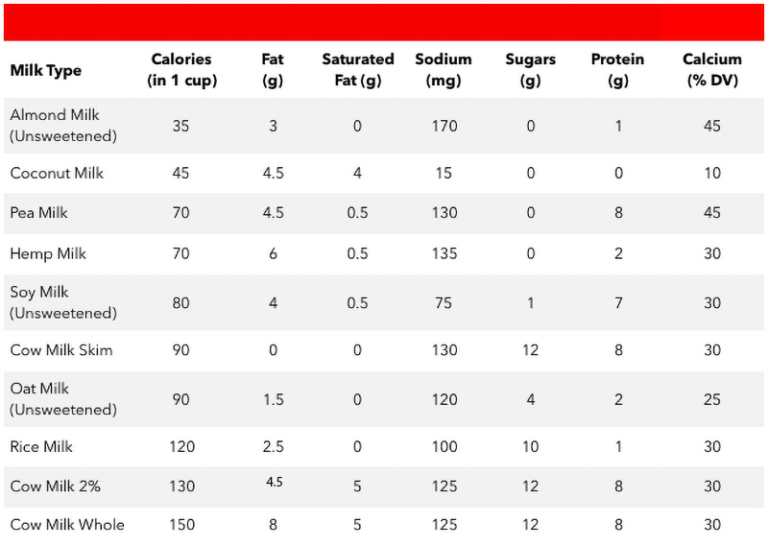Comparing Milks
There are so many milks on the market today! Each new variety comes covered in packaging that touts myriad health claims and nutrient boosts, but which milks actually provide decent nutrition? Take a look at the chart below to find the perfect milk for you... Now let's take a look at all this data. The serving size for all kinds of milk was 1 cup (8 ounces), and we compared store brand products.* If there were several varieties of milk, we chose the unsweetened, unflavored options to compare. Data was gathered from peapod.com.So, how do these kinds of milk measure up?Almond milk was the lowest in calories and one of the highest in calcium, though its protein content couldn’t measure up to traditional cow’s milk or pea milk. Skim milk was the lowest in fat.All plant kinds of milk are cholesterol-free and skim milk, oat milk, and rice milk was lowest in heart-endangering saturated fat. Most of the unsweetened plant kinds of milk were lowest in sugars, though oat milk and rice milk surprised us with their levels of naturally-occurring sugars.By Judy Doherty, BS, PCIIPDF Handout: Milk Comparison Chart*Store brands were available for most products, though in a few select instances, name brands were used.[shopify embed_type="collection" shop="nutrition-education-store.myshopify.com" product_handle="2020-hot-topics"]
Now let's take a look at all this data. The serving size for all kinds of milk was 1 cup (8 ounces), and we compared store brand products.* If there were several varieties of milk, we chose the unsweetened, unflavored options to compare. Data was gathered from peapod.com.So, how do these kinds of milk measure up?Almond milk was the lowest in calories and one of the highest in calcium, though its protein content couldn’t measure up to traditional cow’s milk or pea milk. Skim milk was the lowest in fat.All plant kinds of milk are cholesterol-free and skim milk, oat milk, and rice milk was lowest in heart-endangering saturated fat. Most of the unsweetened plant kinds of milk were lowest in sugars, though oat milk and rice milk surprised us with their levels of naturally-occurring sugars.By Judy Doherty, BS, PCIIPDF Handout: Milk Comparison Chart*Store brands were available for most products, though in a few select instances, name brands were used.[shopify embed_type="collection" shop="nutrition-education-store.myshopify.com" product_handle="2020-hot-topics"]


